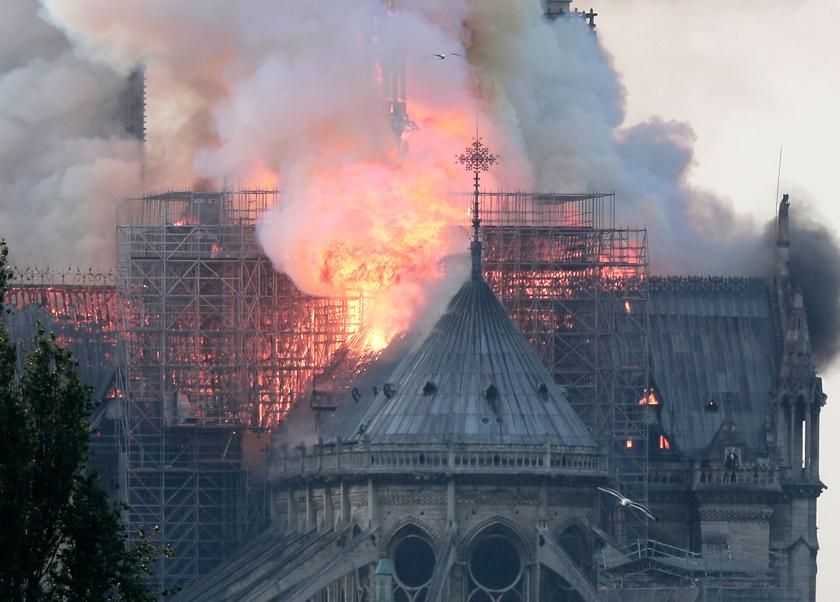One year on the world is drastically altered, but footage of Notre Dame’s stricken spire collapsing in flames is no less shocking. That this event, endlessly replayed, has not paled against the new reality of daily death tolls is testament to the scale of the loss. As the rector of Notre Dame, Patrick Chauvet put it: “Notre Dame is not just Paris, it’s France and beyond France, it’s the world.”
By the time a fire was discovered at 6.43pm, more than 30 minutes had elapsed since a sensor had detected smoke in the attic, and Notre Dame, one of the great monuments of Gothic architecture, was ablaze. An alarm was received by the security team, but instead of investigating the roof immediately, they made a detour via the sacristy.
The reasons for this delay were not pursued in the film, a peculiar decision, given the pivotal importance of those 30 wasted minutes. Luke Bisby, a fire safety researcher at Edinburgh University gave it to us straight: “In a situation like this, 5, 10, 30 minutes makes all the difference.”
Reconstructing the massive timber roof, known as “the forest”, will require approximately 1300 oak treesInstead, with the help of footage, graphics and eyewitness interviews, the events of 15 April 2019 were replayed, the unfolding tale a reminder that fire makes a truly formidable opponent. In a horrible twist, the collapse of the spire made matters worse, the sudden influx of air accelerating the flames, which, assisted by a rising wind, engulfed the entire roof and began to threaten the bell towers. Had the wooden scaffold inside the north tower caught light, its eight bells would have dropped like wrecking balls, triggering a chain reaction that would have brought down the whole building.
Firefighters struggled with hopelessly inadequate equipment, but eventually, guided by the structural expertise of historic buildings architect Rémi Fromont, the fire was put out at 9.30am the next day. The flames had gone, the bell towers were still standing, but Notre Dame was still in imminent danger of collapse, and heavily contaminated with lead dust. Were the stricken roof to fall in, the flying buttresses would have overwhelmed the walls, causing the entire structure to fall.
A race against time ensued, and a team, headed by Philippe Villeneuve, France’s chief architect of historic monuments constructed timber frames for each of the 28 flying buttresses. With the walls secure, the team could turn its attention to the removal of fire-damaged scaffolding, installed in preparation for restoration work last year, but now a mass of twisted metal.
Covid-19 has put this phase of the project into abeyance, but only when the scaffolding is safely removed can the roof be sealed, and work on the rebuilding begun. For the architects, scientists, historians and craftspeople involved, rebuilding Notre Dame requires an unprecedented knowledge and understanding of medieval techniques and materials, knowledge that will not only assist this rebuilding, but be handed on to future generations in the form of a data-rich model that is being called Notre Dame’s digital twin.
The patient work of armies of experts and specialists is awe-inspiring and often cheering, as the cathedral’s 13th century glass emerged as a surprise survivor, protected in places by century-old dust. But their efforts highlight too the folly of Macron’s pledge to rebuild the cathedral in five years. The source of the limestone in the vaults has been located to the quarries beneath Paris, repurposed as catacombs in the 18th century: a new, viable source has yet to be found. Reconstructing the massive timber roof, known as “the forest”, will require approximately 1300 oak trees, each one hand-selected for size and shape, each one felled and hewn by hand, by specialists in medieval carpentry. The enormity of the project is overwhelming, and as he shook hands with a colleague having successfully felled a single tree, one carpenter explained: “I like the feeling that you have to put so much effort into one tree, it gives you a little bit of respect”.
On the day that Notre Dame’s great bell rang to honour medical staff treating Covid-19 patients, Macron reiterated his commitment to reopen Notre Dame in 2024. One obstacle to be overcome is the question of how to rebuild the spire, itself a 19th century replacement for a 13th century timber spire that was removed in the 18th century. A competition to design a new spire was launched last year, and the dispiriting array of entries has caused huge upset in France and beyond.
Meanwhile, we are no nearer to knowing how the fire started, only that it may have been caused by a poorly extinguished cigarette, or an electrical fault. But what is certain is that the disaster is yet another example of historic sites damaged by fires that coincide with conservation work, with Windsor Castle, the Cutty Sark and Notre Dame de Luxembourg all notable examples. The urge to make new, and quickly, is popular and politically expedient, but it must be challenged, beginning with Notre Dame.















Add comment